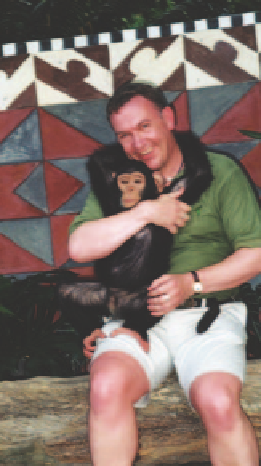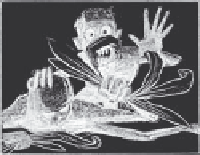Graphics Reference
In-Depth Information
Body language
I wonder whether always having had pets around has helped me anthropomorphise
characters. My last three cats, the glorious Inigo, Scrumpy and Benjamin, have all been highly
involved with my life and we seem to have been able to communicate and respond to each
other in pretty complex ways. Now the accuracy of the emotions I have read into their body
language may have been fanciful, but it has been an excuse to watch Inigo when he came
bounding up to me as I arrived home and to see what is it about his body and movement
that is expressing such an obvious joyful emotion. I liked watching him to see whether his
stretching out of a paw is actually a prehensile movement or just an instinctive one. I was
surprised once that when I was laid low by a bug, Inigo seemed clearly distressed by all the
coughing and spluttering and just came and laid a single paw on my cheek. I never tire of
watching animals move, especially all their dif erent rhythms when using four legs. Animating
four legs on a puppet is always a logistical nightmare, and never something that comes easily.
I always enjoy being up close with animals and responding to them. At a festival in Singapore
I went to the zoo, where the animals seemed very well looked after. A large ape was being
upstaged elsewhere, and threw some fruit at me and started gesticulating. He clearly wanted
it thrown back, and we began a game of mirrored actions. It was an extraordinary moment to
see this animal making very precise articulated gestures, and mimicking me, and for a moment
it felt as though I was manipulating a puppet, or being manipulated. Studying any sort of body
language can only help us as animators, but I'm still surprised
as how expressive animals can be, especially vocally.
Inigo had a vocabulary of several dozen 'words, each
accompanied by a particular body language, and I knew
exactly what he meant by every one of them. Since most
stop motion i lms, well most animated i lms, inevitably,
involve animals, we cannot study them too often. There's
something very direct and honest about an animal's
movements. Sure, they can trick and outwit, and be cunning,
but I'm not sure an animal is capable of deliberately lying
or deceiving or hiding what it feels. It's pretty easy to look
at a cat's body language to tell whether it is contented or
frightened, but there are many subtleties involved. There are
so many clues, and it is these that animators need to be able
to read clearly and use in their characters. Inigo was a rescue
cat, and a pretty damaged untrusting one, who couldn't
even play, but I won his trust by some rather over-obvious
body language. Lying on my back next to him, exposing my
stomach with my limbs in the air clearly struck some sort of
chord and he would follow suit. I have yet to use that exact
gesture in a i lm, but it's not hard to understand the emotional dif erence between
arms folded protectively over the stomach and arms l ung wide open, exposing
the vulnerable areas. Every time I look at an animal, I am mentally storing its
movements in my head.
Clearly not a timid animal.
These are quite natural gestures, and can be explained psychologically: you are not
likely to expose your vulnerable areas to someone you don't trust. Such gestures



Search WWH ::

Custom Search